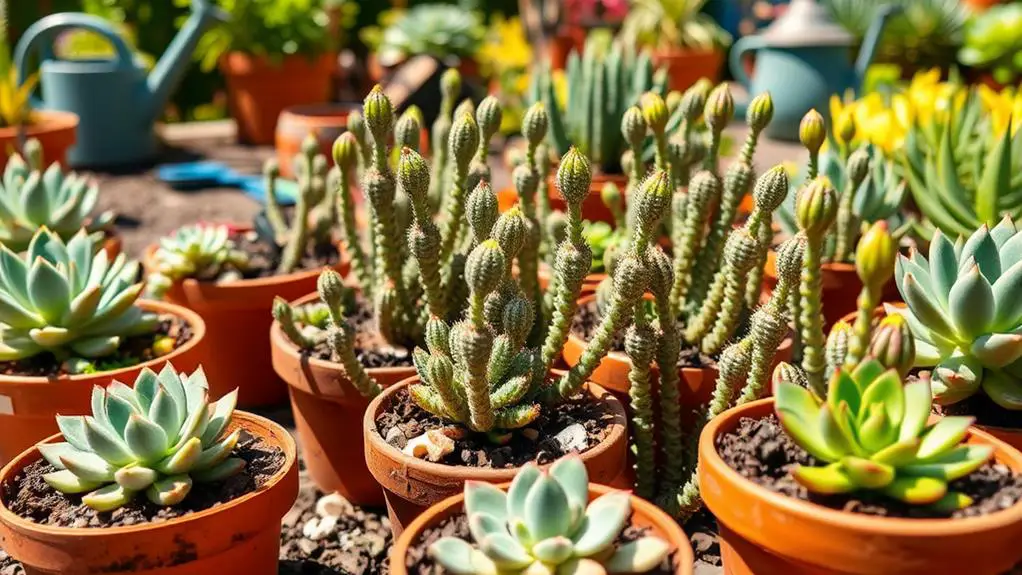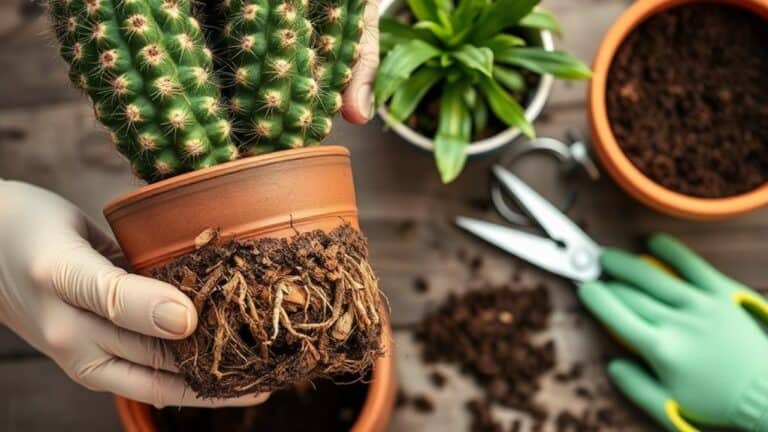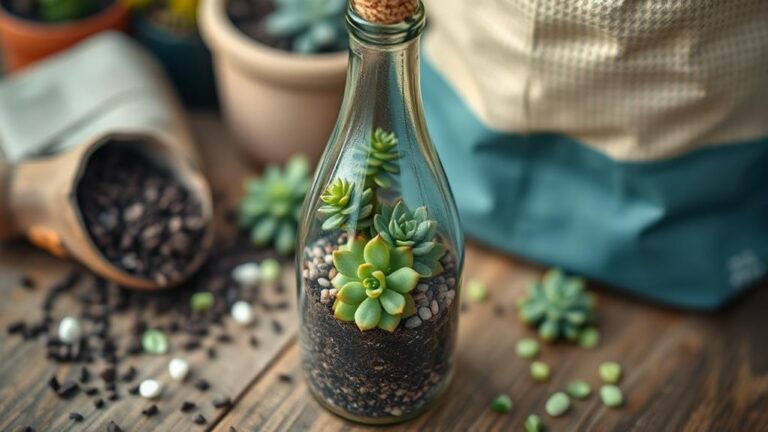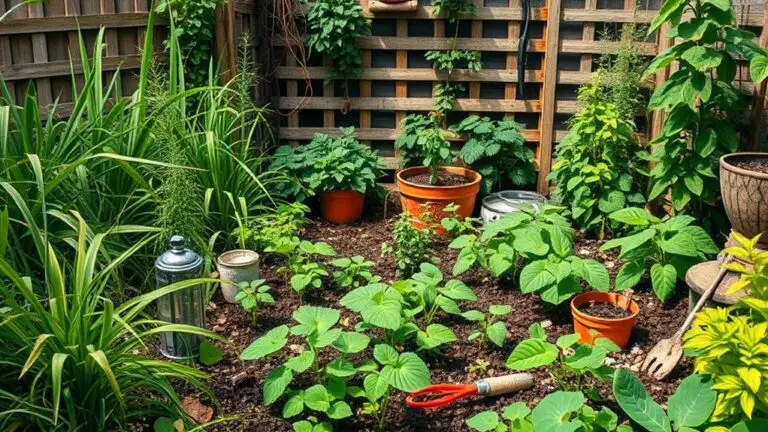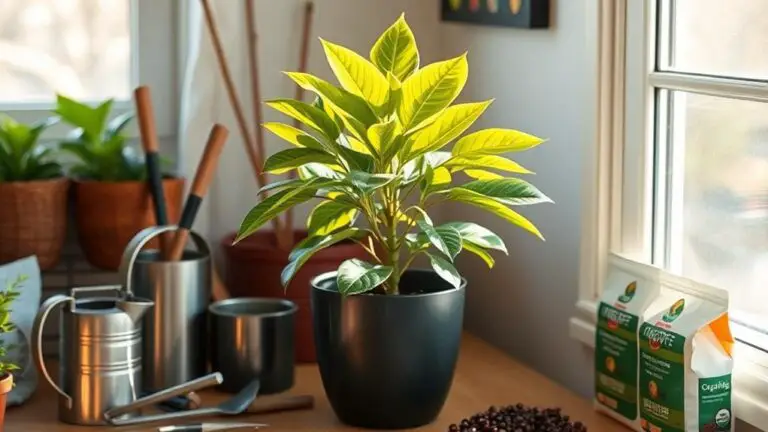Everything You Need to Know About Growing and Caring for Succulent Offshoots
If you're looking to expand your succulent collection, understanding how to grow and care for offshoots, or pups, is vital. These small offshoots are a form of asexual reproduction and can thrive with the right care. You'll need to guarantee the mother plant is in good health before removing the pups with clean tools. After detaching, there's a significant step that most people overlook, which can make or break the success of your new plants. Curious about what it is? Let's explore the secrets to successfully nurturing these resilient plants.
Understanding Succulent Offshoots

When it comes to understanding succulent offshoots, it's important to recognize that these tiny replicas of the parent plant are a demonstration of the mother plant's liveliness. Offshoots, or pups, are a form of asexual reproduction, allowing you to propagate succulents without needing pollination. This means the baby plants are exact copies of the mother plant.
Common succulent varieties like Sempervivum, Aloe, Agave, and Echeveria often produce offshoots when they're healthy and well-cared for. You'll usually find these baby plants growing at the base of the mother plant or along its stems. Their presence is a signal that your succulent is thriving, capable of producing new growth and supporting its little ones.
To successfully propagate succulents using offshoots, you need to separate them from the mother plant gently. Once separated, make certain to provide the baby plants with proper sunlight, moisture, and well-draining soil. This helps them establish themselves and grow into strong, independent succulents.
Understanding succulent propagation through offshoots is a rewarding process. It not only shows your plant care skills but also allows you to expand your succulent collection effortlessly. By following these steps, you'll guarantee your succulents remain healthy and vibrant.
Types of Succulents Producing Offshoots

Recognizing the types of succulents that produce offshoots can help you expand your collection with ease. Sempervivum succulents, often called "hens and chicks," are famous for their ability to produce numerous offshoots. These offshoots, or "chicks," spread around the mother plants, making them perfect for filling up your garden quickly.
Aloe plants are another great option. They produce pups at the base of the mother plants, which can be separated and replanted. This makes propagating succulents like Aloe both simple and rewarding.
Similarly, Agave succulents create offshoots known as "pups" from the base, especially after flowering, giving you new plants to enjoy.
Haworthia species are also excellent for propagation. They generate small offsets that you can gently remove and replant. These succulents are particularly good if you're looking for easy-to-care-for plants.
Sedum varieties, including Mother of Millions and Mother of Thousands, are incredibly prolific in producing offshoots. These offshoots quickly establish new plants, making them a fantastic choice for expanding your collection.
Tools and Materials Needed

To successfully propagate succulent offshoots, having the right tools and materials is vital. First, you'll need clean, sharp scissors or a knife. This guarantees a precise cut without damaging the plant. Dull tools can cause harm and increase the risk of infection.
Gardening gloves are a wise choice to protect your hands from sap and potential irritation, especially with certain succulent varieties.
Next, prepare a new pot for the offshoots. It's essential that the pot has drainage holes. Without these, water can accumulate, leading to root rot.
Fresh potting soil that matches the mother plant's mix is also necessary. This soil will provide the right nutrients and drainage conditions for your offshoots to thrive.
Additionally, consider using coconut coir. This material helps retain moisture during the initial propagation phase, giving your offshoots a better start.
Make sure you're using fresh, high-quality soil to support healthy growth.
Removing Offshoots Safely

Removing succulent offshoots safely guarantees the health of both the mother plant and the new offshoot. To do this, start by using clean, sharp scissors or a knife. This provides a clean cut, which is vital for the baby plant to grow properly.
When removing offshoots, make sure they're at least 1/4 to 1/2 the size of the mother plant for the best chance of successful rooting. If the offshoot resists cutting, gently twist or wiggle it. This can help separate it without damaging the surrounding tissue of the mother plant.
Be gentle to avoid harming either plant. Once you've made the cut, it's important to allow the offshoot to dry and form a callus for 1-3 days. This step helps prevent rot when you eventually plant the new offshoot.
Don't forget to wear gardening gloves to protect your hands from sap and possible irritation. Following these steps guarantees that your new plants will thrive and grow strong.
Removing offshoots might seem tricky at first, but with a little care and attention, you'll be able to do it successfully every time.
Planting Offshoots

Often, planting succulent offshoots is the exciting next step after successfully detaching them from the mother plant. First, make certain you have a clean, sharp tool to gently separate the new baby from the parent. This helps minimize damage and stress. After detachment, let the offshoots callus for 1-3 days to prevent fungal infections.
Next, prepare a new pot with fresh, well-draining succulent or cactus soil. This is vital to prevent root rot. If you want, you can dip the base of the offshoot in rooting hormone to encourage faster root growth. When planting, make certain the base of the offshoot is in contact with the soil line for stability.
Here's a quick reference table for the process:
| Step | Description | Tip |
|---|---|---|
| Detaching Offshoots | Use a clean, sharp tool to separate from the mother plant | Minimize damage |
| Preparing the Pot | Use fresh, well-draining succulent or cactus soil | Prevent root rot |
| Planting the Offshoot | Place the base in contact with the soil line | Make certain stability |
After planting, place the pot in an area with bright, indirect sunlight for about 8 hours a day. Don't water immediately; wait until you see root growth, typically within 2-3 weeks. Misting the soil lightly can help maintain moisture without over-saturating. Happy planting!
Caring for Newly Planted Offshoots

To help your newly planted succulent offshoots thrive, make sure they get around 8 hours of bright, indirect sunlight each day.
Mist them weekly to keep the soil moist but not too wet, since too much water can cause root rot.
Adding a thin layer of coconut coir on top of the soil can also help maintain the right moisture levels.
Optimal Light Conditions
Newly planted succulent offshoots need bright, indirect sunlight for around 8 hours daily to thrive. This is vital for creating ideal light conditions that encourage healthy growth without causing sunburn.
When growing succulents, it's important to avoid placing your offshoots in direct sunlight immediately after planting. Doing so can lead to excessive moisture loss and potential damage.
If natural light is limited, especially during the winter months, consider using fluorescent lights like T5 fixtures. These lights can provide consistent light conditions, guaranteeing your succulents get the brightness they need.
If you're growing them indoors, don't forget to rotate your offshoots periodically. This practice guarantees even light exposure, promoting more uniform growth.
Monitoring light levels is also significant. As your offshoots grow, you may need to adjust their placement to prevent stretching.
Stretching occurs when succulents reach for light, resulting in leggy and less compact plants. By keeping an eye on the light conditions and making necessary adjustments, you can help your succulents stay healthy and robust.
Watering and Moisture Management
When caring for newly planted succulent offshoots, consistent moisture management is crucial for their successful establishment. To start, misting your new succulents weekly helps maintain the right soil humidity. This gentle watering method guarantees they get the moisture they need without over-saturating their delicate roots.
It's also a good idea to add a thin layer of coconut coir on the soil surface. This material helps retain moisture, especially during the early growth phase, giving your offshoots a better chance to thrive.
Remember, your new succulents need bright, indirect sunlight for about 8 hours daily. This guarantees they get enough light for photosynthesis while preventing the soil from drying out too quickly.
Allowing the soil to dry out between waterings is another key step. Typically, you should wait about 1-2 weeks before re-watering based on the moisture level. This practice helps prevent root rot, which can be fatal to your plants.
Keep an eye on your offshoots and monitor them regularly. If you notice any signs of wilting or dryness, adjust your watering schedule accordingly. With these tips, you'll be well on your way to growing healthy, vibrant succulents.
Common Challenges and Solutions

When growing succulent offshoots, you'll face some common challenges like pests and root rot, but don't worry—there are solutions.
To prevent root rot, make sure to let the soil dry out between waterings, usually waiting 10-14 days.
For pests like aphids, keep an eye on your plants and use insecticidal soap or neem oil if you spot any trouble.
Identifying Common Pests
Among the challenges succulent enthusiasts face, common pests like aphids, mealybugs, and spider mites can wreak havoc on your plants. These pests suck sap from your succulents, causing damage and potentially stunting growth.
Let's explore how to identify and manage these pesky invaders.
Aphids are small, soft-bodied insects that produce a sticky substance called honeydew. This can attract other pests and lead to sooty mold on your succulent leaves. If you notice a sticky residue or black mold, aphids might be the culprits.
Mealybugs are easy to spot thanks to their cotton-like appearance. They often hide in leaf axils or under leaves, making early detection essential. Regularly inspect your plants, especially in those hidden spots, to catch them early.
Spider mites thrive in dry conditions and create fine webbing on plants. You might notice tiny specks moving on the leaves. Increasing humidity by misting your plants can help prevent these infestations.
For effective pest management, consider using insecticidal soap or neem oil. Introducing beneficial insects like ladybugs can also help control pest populations naturally.
Stay vigilant, and your succulents will thrive despite these common challenges.
Preventing Root Rot
Root rot can sneak up on even the most diligent succulent growers, but a few key strategies can keep your plants healthy.
To start, preventing root rot begins with your watering habits. Overwatering is the main culprit, so let the soil dry out completely between waterings. Typically, every 10-14 days works well depending on your environment.
Next, always use well-draining soil. A cactus mix or a blend of potting soil and perlite helps excess moisture escape, which is vital. If your soil holds too much water, your succulent's roots can begin to rot.
Equally important are drainage holes in your pots. They allow extra water to escape, preventing it from sitting at the bottom and causing root decay. Without drainage holes, your succulent is at risk, no matter how careful you're with watering.
Regularly check your succulent offshoots for any signs of root rot, like mushy or discolored roots. If you spot any, remove the affected areas promptly to stop the disease from spreading.
Lastly, consider watering methods. Avoid getting water on the leaves and try bottom watering to reduce the risk of root rot.
These simple steps will help keep your succulents thriving.
Frequently Asked Questions
How to Grow Succulents From Offshoots?
To grow succulents from offshoots, carefully detach them using clean tools, let them dry for a few days, then plant in well-draining soil. Mist lightly weekly and keep in bright, indirect sunlight for healthy growth.
How to Encourage Succulent Offshoots?
You'll encourage succulent offshoots by keeping the mother plant healthy. Provide bright, indirect sunlight for 8 hours daily, water regularly during its growing season, prune to promote growth, and use well-draining soil with coconut coir.
How to Care for Succulent Pups?
To care for succulent pups, give them bright, indirect sunlight for 8 hours daily. Mist weekly, let soil dry between watering, and watch for pests. Once roots establish, transfer them to larger pots for better growth.
When to Replant Succulent Pups?
Replant succulent pups when they're 1 to 2 inches in size with a few roots. Spring or summer is ideal since succulents are actively growing. Guarantee well-draining soil and wait 2-3 weeks before watering to promote root development.
Conclusion
You've got everything you need to grow and care for succulent offshoots. With the right tools and a little patience, you'll see these tiny plants thrive. Remember to give them bright, indirect sunlight, keep the soil well-draining, and mist them gently. If you face any challenges, don't worry—you're equipped to handle them. Keep an eye out for pests and enjoy watching your succulents grow. Happy gardening, and have fun with your new plant friends!

